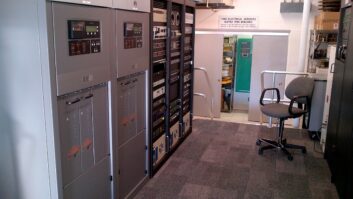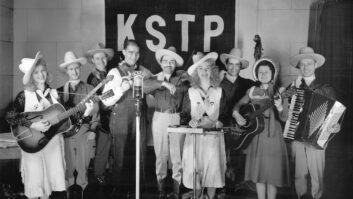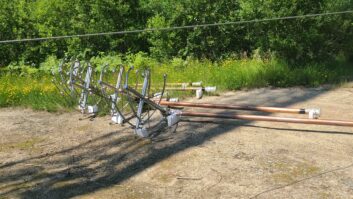OTTAWA — The very different Falkland Islands (South Atlantic Ocean), Roxby Downs (the Australian Outback), and the Shetland islands (the North Sea) have two things in common. First, they are all very remote locations that are distant from the rest of the world. Second, all three depend on independent local radio stations who keep their isolated listeners informed, entertained, and connected to each other.
FALKLANDS RADIO
Located in the South Atlantic east of South America, the United Kingdom’s Falkland Islands is a very remote, isolated location. Before Argentina invaded the main two islands in April 1982, and was subsequently evicted by Britain armed forces two months later, most people had never heard of this windswept territory.

However, the Falklands have been a British possession since the first Scottish and Welsh settlers came here in 1833. The 2,841 people here prosper by raising sheep for wool, and resupplying ships that stop at Stanley, the main port, on East Falkland Island.
Providing everyone here with music, local news and weather via wireless is the job of Falklands Radio, which broadcasts on five FM frequencies throughout the islands. It also streams to the world at www.radio.co.fk.
“There has been a radio broadcasting service in the Falkland Islands since 1929, when a wired service was installed in the islands’ capital, Stanley,” said Corina Goss, Falkland Radio’s station manager. “The station has developed and grown over the years and currently employs 6.5 full-time staff and about 15 freelancers.”

Falklands Radio’s two-floor building in Stanley is “spacious,” she noted. “We have two studios, a news room, office spaces and a large archive upstairs.” The main FM transmitter and antenna are based in Stanley (on 88.3 MHz FM), with four retransmitters and antennas located around the two main islands. The station is on air 7 a.m.–10 p.m. weekdays; 9 a.m.–10 p.m. Saturdays, and 4 a.m.–10 p.m. Sundays.
The programming format used by Falklands Radio can safely be described as variety. “Our daytime shows feature a mix of music genres and talk content,” said Goss. “Meanwhile, our evening shows target the more specialist audience and range from classical music, to rock music and almost everything in between.”
“Our audience is made up from listeners of all ages and all walks of life living in the Falklands,” she said. “We even have a show just for children.”

Falklands Radio’s regular presenters also come from many walks of life. “Three of the full-time staff, myself included, stood for election, unsuccessfully, in the 2017 general election in the islands,” said Goss. “Our current staff members include: a former member of the Legislative Assembly, a former attorney general and a former I.T. business owner.”
LOCAL AND NATIONAL COVERAGE
“We also provide two in-depth local news bulletins each weekday,” she said. “Our reporters strive to cover news items to suit all tastes. It would not be at all uncommon for a reporter to spend a morning in the court, attend a school concert, follow that up with a meeting about agriculture and finish the day with a reception at Government House.”
To say the least, Falklands Radio is quite different than a typical urban radio station in Europe or the Americas. “One of the main areas in which we are fairly unique, is that as well as being the only community radio station, we are also the only national radio station,” said Goss. “Falklands Radio must therefore ensure that content covers items relating to everyday living as well as those which are of national importance.”
Operating a radio station in the remote Falkland Islands comes with its own particular dilemmas. “Ensuring the right balance between being a local and a national broadcaster can be challenging,” she said. “Staffing can sometimes prove to be challenging too. In a small community there is only a limited pool of people who are able, or willing, to work in such a public position.”
On the positive side, Falklands Radio has a very loyal audience. Streaming on the web has also extended the station’s reach. “We now have listeners tuning in from all over the world,” said Goss. “Recently we had a listener from Germany enter one of our competitions.”
“Possibly the most rewarding aspect of the job, is receiving positive feedback from the listeners,” she added. And although Falklands Radio is the only local broadcaster in town (the BBC World Service does come in via satellite and is transmitted on local FM), this station does not take its audience for granted. This is why Falklands Radio re-launched in February 2018 with a new format, new shows, new presenters, an updated music library and a new imaging package.
As a result of this, “the station has been receiving numerous messages and calls from listeners who are enjoying the changes,” said Goss. But Falklands Radio is not resting on its laurels: “We are planning to build on the success of our relaunch and will fine-tune our output to ensure that we are providing the best possible service to our listeners,” she said. “As a result of this, we will focus, in the immediate future, on market research.”
AUSTRALIAN OUTBACK
The Australian Outback is legendary for its hot, dry deserts and its remote, wide-open spaces. But the Outback is also home to a wealth of mineral deposits and mines that are important to Australia’s economy, such as the Olympic Dam Mine and processing plant in South Australia. Located in the state of South Australia, the Olympic Dam Mine is home to the fourth largest copper deposit and largest known single deposit of uranium in the world.

The modern town of Roxby Downs (population 4,702) was built in 1987 to provide a modern, fully equipped community for the mine’s work force. This town is right in the middle of what many people would describe as “nowhere.”
Providing Roxby Downs and the mine/processing plant with music of all genres, news, and local information is the job of RoxFM. It is a community radio station and is Roxby Downs’ only broadcaster. RoxFM can be heard locally over the airwaves on 105.5 MHz FM, and anywhere in the world via its audio stream at www.roxfm.com.au.
[Read: RNZ Pacific Using DRM to Feed Pacific Relay Stations]
The town government of Roxby Downs was eager to set up its own community radio station back in 1987. But it wasn’t until 2003 that all the necessary legal and regulatory hurdles were cleared, and RoxFM was set up in part of the town’s Leisure Centre; right in the middle of everything.
“I think the location and the people give RoxFM its uniqueness,” said Jordan Curtis, RoxFM’s station manager and its only paid employee. “We’re a very small town six-and-a-half hours away from the nearest large city, Adelaide — and so we have to be creative to keep ourselves entertained. We’re lucky enough to have about 18 dedicated volunteers who come in and present on air, and help out at outside broadcasts. RoxFM really wouldn’t be what it is without them.”

To keep its listeners entertained at all times, RoxFM broadcasts 24/7. Although the station’s on-air schedule is largely filled by an automated music playout system, RoxFM does feature locally produced live programs such as “Brain Chamber,” “Man Cave” and “The Vibe.” “‘Man Cave’ and ‘The Vibe’ are a couple of our longest standing programs, and everyone involved in both shows really enjoy themselves,” said Curtis.
“‘Brain Chamber’ is our new on-air quiz show, produced by a local teacher and his partner who works with a community health program in town. They put a lot of effort into their show which really reflects their passion for what they do on RoxFM.”
As well, sometimes RoxFM’s volunteers stage a live broadcast marathon at the station. “Last month we rallied the troops and had at least one person in the studio for a whole 24 hours,” he said. “It was an exhausting exercise, especially at 3 a.m., but it was a fun time. By the time midnight came around, the station ended up being hijacked for karioke! It’s one of those things that would only happen in a town like Roxby Downs.”
SMALL BUT EFFICIENT
Technically speaking, RoxFM’s production facilities are small but efficient. “RoxFM has three rooms: The studio, the front of the station where my desk is, and a backroom we use for recording,” said Curtis. “Our studio has three microphones, a couple of CD players and one very hard working computer. Our setup in the studio is pretty simple, but it does everything we need it to do!”
RoxFM’s antenna and transmitter are located in the town’s transmission shed, which is the same place where the town’s commercial TV/radio, and government-funded public TV/radio transmitters are housed. “It makes everything easier for the people who take care of that whole setup to have it all in one spot,” he said, “and it means RoxFM isn’t on our own if something goes wrong.”
As a community radio station, RoxFM doesn’t have access to the life-sustaining advertising revenues that large commercial Australian stations do. (It is allowed to earn money from program sponsorships.) So having enough money on hand to pay the bills can be a challenge.
“We’re a very small station with limited resources, and fundraising in a place like this can be tricky,” said Curtis. “We do our best though and keep pushing, because in the end we’re the only media outlet based in town.”
Apparently RoxFM is doing something right, because the people of Roxby Downs are listening. “Every now and then somebody in town will mention something they heard on-air that they enjoyed, and for me to know that at least one person is getting something out of RoxFM is rewarding in itself,” said Jordan Curtis. “The reward really is the knowledge that RoxFM is a place that people want to keep coming back to and listen to.”
People around the world are also tuning into RoxFM via its audio stream. “One day when I got to work and checked my emails I noticed that I’d received an email from a man who worked for a law firm in Ireland,” Curtis said. “He had tracked down the station’s contact details so he could ask for the name of a song he had heard on RoxFM while randomly channel hopping through online radio stations. (The song was “Echo Back” by the New Zealand band Lucid 3.)
RoxFM is here to serve the local community, but I don’t see why the rest of the world can’t enjoy what we do too.”
NORTH SEA LOCAL RADIO

Located above the very top of Scotland in the frigid North Sea, the windswept Shetland Islands are known for fishing, sheep herding, farming, and, in recent years, oil and gas production. The largest of the Shetland Islands is known as “the Mainland,” and it is here that the husband-and-wife team of Ian Anderson and Inga Walterson operate the Shetland Islands Broadcasting Company (SIBC) as a privately owned local station.

Since signing on Nov. 26, 1987, SIBC has built its reputation by offering original content 24/7. The station’s studios are located in a one-storey building on Market Street, Lerwick; the Shetland Islands’ largest port. The format is “Hit music and local music, which we make hit music,” said Ian Anderson in a series of tightly written emails to Radio World. “Local news 24/7/365.” SIBC’s broadcasts are aimed at “The Shetland Islands area and anyone outside the area that wants to listen.”
In fact, SIBC broadcasts on two FM frequencies. The first, a standby frequency, is 102.2 MHz FM in Lerwick on a 15-meter tower. SIBC’s second and main frequency is 96.2 MHz FM on the Shetland island of Bressay using a 70-meter tower transmitting “15 kW ERP from 190 degrees to 010 degrees — nothing to the east where there is only the North Sea,” said Anderson. Online, anyone can tune into SIBC’s audio stream at www.sibc.co.uk.
Between these two sites, SIBC stands out as “The only commercial radio station for 200 miles,” Anderson said. The station prides itself on providing detailed local news coverage; including stories such as “passenger movements at Sumburgh airport grew by almost 18 percent, or over 63,000, in the last financial year to 419,000” and “between June 2016 and June last year the population of Shetland fell by 120, even although there were 14 more births than there were deaths.” SIBC also covers world news and music in all of its varieties, in a smooth-flowing format that is professional and easy on the ears.
For Anderson and Walterson, the main challenge of operating SIBC as a family business is “economics; knowing income is going to be modest and running the station within its means.” In terms of its impact on SIBC, offering an audio stream to the world has “been considerable in numbers, less so in hours and insignificant in income,” said Anderson. Still, the benefit of running this family-owned station is the “same as all family-owned businesses, we are our own bosses,” he said. “And we are still in radio, the business we love.”
James Careless reports on the industry for Radio World from Ottawa, Ontario.







